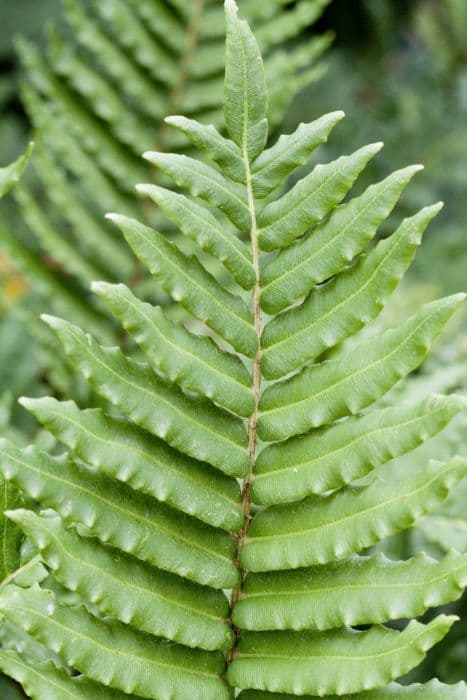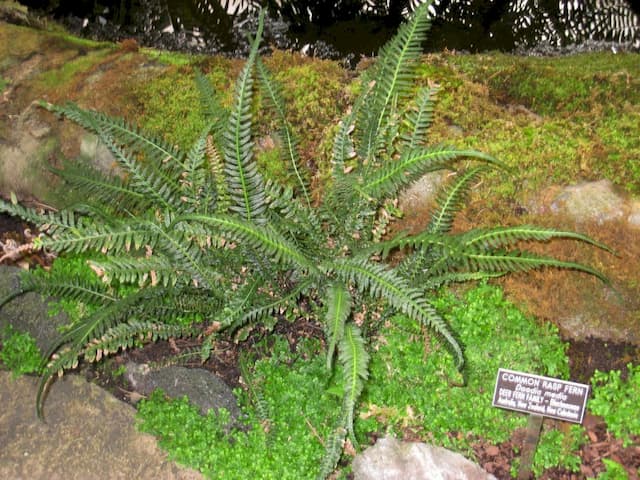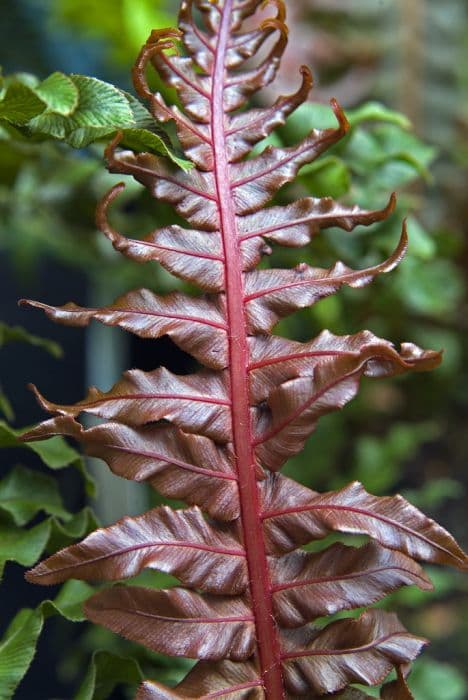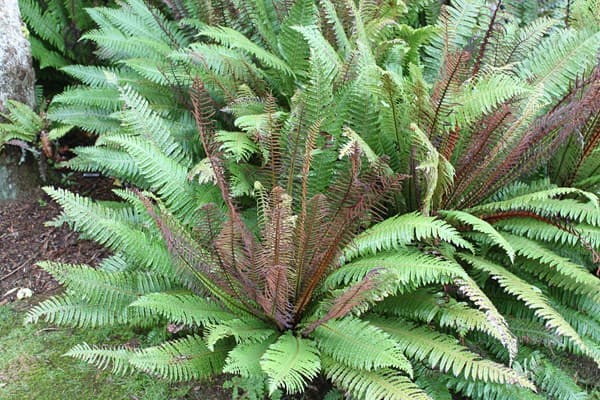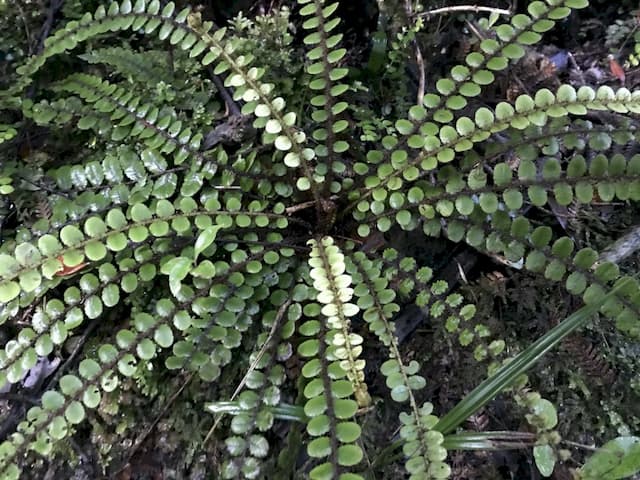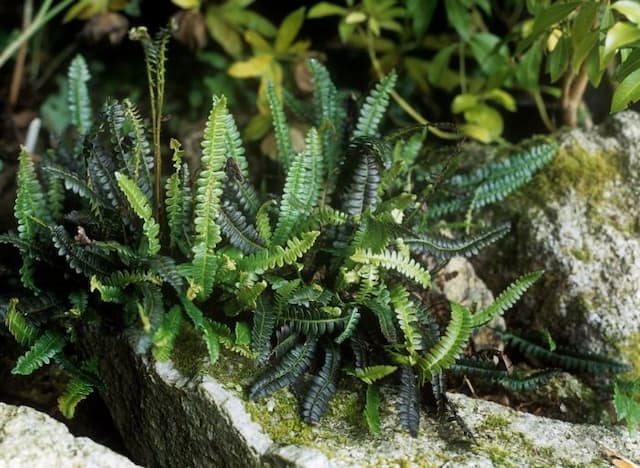Silver Lady Fern Blechnum gibbum

ABOUT
The plant known as Silver Lady Fern or Dwarf Tree Fern is a species that boasts an elegant, lush appearance with a somewhat palm-like vibe due to its form and structure. Its foliage consists of long, arching fronds that have a delicate, feathery appearance. These fronds grow in a symmetrical rosette pattern, radiating outward from the central part of the plant. The green color of the leaves is bright and glossy, giving them a vibrant and fresh look. As the name "tree fern" suggests, this plant possesses a slender, erect 'trunk' that supports the crown of fronds above. The trunk is not like the woody trunks of trees we are generally familiar with; instead, it's more fibrous and maintains a narrower shape. The unfurling new leaves, often referred to as "fiddles" or "croziers," emerge from the top of the trunk, starting off as tightly coiled spirals that gradually open out into the full, flat frond shape. These new leaves add an additional visual interest as they can have a slightly different color or tone when they are young, contrasting with the older, darker green fronds. The texture of the leaves is also noteworthy, as they are smooth to the touch and do not have any rough edges or thorns. The plant's overall shape and texture combine to create a graceful, soft silhouette, which can add an element of delicate natural beauty to its surroundings. Despite its common name, Silver Lady Fern, there is not a pronounced silver hue to the fronds, but the term may refer to the light green, almost silvery sheen seen on the new foliage. Overall, Silver Lady Fern is prized for its tropical look and its ability to bring a sense of lushness and verdant beauty to any space it occupies. Its arching fronds and symmetrical growth habit create a pleasing aesthetic that can evoke the feeling of a miniature tropical paradise.
About this plant
 Names
NamesFamily
Blechnaceae
Synonyms
Miniature Tree Fern, Dwarf Tree Fern, Silver Lady Fern
Common names
Lomaria gibba, Blechnum moorei, Struthiopteris gibba.
 Toxicity
ToxicityTo humans
Silver Lady Fern is generally not considered toxic to humans. There are no well-documented cases of poisoning by this plant, and it is commonly kept as a houseplant with no reports of adverse effects from casual contact or ingestion. However, as with any plant, individual allergies or sensitivities can't be entirely ruled out, and it's always advisable to keep plants out of the reach of young children who might ingest them out of curiosity.
To pets
Silver Lady Fern is not known to be toxic to pets either. This fern is generally considered safe around cats and dogs, and there are no specific toxic effects associated with it. While ingestion of any non-food plant material can potentially cause mild stomach upset in pets, Silver Lady Fern is not associated with serious health risks. Nonetheless, preventing your pets from chewing on any houseplants is still a good practice to avoid any potential issues.
 Characteristics
CharacteristicsLife cycle
Perennials
Foliage type
Evergreen
Color of leaves
Green
Height
3 feet (0.91 meters)
Spread
3 feet (0.91 meters)
Plant type
Fern
Hardiness zones
9
Native area
Fiji, New Caledonia
Benefits
 General Benefits
General Benefits- Decorative: The soft, feathery fronds of the Dwarf Tree Fern add an elegant, tropical touch to indoor and outdoor spaces.
- Easy to Grow: This fern is relatively easy to care for, requiring only moderate light and consistent moisture.
- Humidity Loving: Thrives in humid environments, making it a good choice for bathrooms or kitchens.
- Shade Tolerant: Can grow in shaded areas where other plants might struggle to thrive.
- Non-Toxic: Safe for homes with pets and children, as it is not known to be toxic.
- Space Filler: It can fill in empty spaces in a garden or room with its lush, green foliage.
- Natural Divider: Can be used to create a natural division in garden areas or living spaces without the need for walls or fences.
 Medical Properties
Medical PropertiesThis plant is not used for medical purposes.
 Air-purifying Qualities
Air-purifying QualitiesThis plant is not specifically known for air purifying qualities.
 Other Uses
Other Uses- Silver Lady Fern can serve as a natural humidifier, releasing moisture into the air through a process called transpiration.
- Used in terrariums or bottle gardens, Silver Lady Fern adds a touch of greenery and can thrive in the controlled moist environment that these enclosures provide.
- As an educational tool, Silver Lady Fern provides a living example for botany students to study plant growth, fern reproduction, and the structure of fronds.
- In art, its fronds can be used for botanical prints or to inspire designs due to their unique form and appearance.
- As a natural dye, some fern species' leaves or spores can be used to create shades of green or brown on textiles, though specific dye recipes would need to be developed for Silver Lady Fern.
- In scenic design for theater and film, Silver Lady Fern can be utilized for realistic forest and jungle settings due to its lush and tropical appearance.
- During festive seasons, especially in tropical regions, Silver Lady Fern can be included in flower arrangements or as greenery accompanying floral displays.
- For hobbyists who work with miniature landscapes or model scenes, the delicate leaves can be a realistic addition to miniaturized settings.
- For photographers specializing in macro photography, the intricate patterns of Silver Lady Fern provide interesting subjects to capture.
- As a living mulch for larger tropical plants, the Silver Lady Fern can help retain soil moisture and suppress weeds in garden pots or beds.
Interesting Facts
 Feng Shui
Feng ShuiThe Dwarf Tree Fern is not used in Feng Shui practice.
 Zodiac Sign Compitability
Zodiac Sign CompitabilityThe Dwarf Tree Fern is not used in astrology practice.
 Plant Symbolism
Plant Symbolism- Resilience: Blechnum gibbum, commonly known as Silver Lady Fern, often symbolizes resilience because of its ability to thrive in various conditions and bounce back from neglect.
- Endurance: As a hardy fern, the Silver Lady Fern represents endurance and the capacity to endure challenging environments.
- Elegance: With its delicate fronds and graceful form, this fern is associated with elegance and an aesthetic charm.
- New Beginnings: Ferns in general, including the Silver Lady Fern, can signify new beginnings or hope as they are often among the first plants to grow in new or disrupted environments.
 Water
WaterThe Silver Lady Fern should be watered thoroughly, allowing excess water to drain freely. Typically, watering once a week should suffice, but this can vary depending on environmental conditions. Always check the top inch of soil for dryness before watering; if it feels dry, it's time to water. Use about 16 ounces of water for smaller pots or up to 1 gallon for larger pots every watering session to ensure the soil becomes adequately moist but not soggy. During the winter months, reduce the frequency of watering as the plant's growth slows down.
 Light
LightThe Silver Lady Fern thrives in bright, indirect light. It's best positioned in a spot where it can receive filtered sunlight, such as near a north-facing window or a few feet away from an east or west-facing window where direct sun is minimal. Avoid placing it in direct sunlight as this can scorch the fronds.
 Temperature
TemperatureThe Silver Lady Fern prefers a temperature range between 60 and 80 degrees Fahrenheit. It can tolerate a minimum temperature of around 50 degrees Fahrenheit, but temperatures below this may damage the plant. The ideal conditions are a consistently warm and humid environment akin to its native tropical habitat.
 Pruning
PruningPruning the Silver Lady Fern is generally done to remove dead or yellowing fronds and to maintain the plant's shape. Prune as needed by snipping off the undesirable fronds at the base. The best time for pruning is in the spring or summer when the plant is actively growing. This will also encourage new growth and improve air circulation within the fronds.
 Cleaning
CleaningAs needed
 Soil
SoilSilver Lady Fern thrives in well-draining, humus-rich soil with a pH of slightly acidic to neutral, around 5.5 to 6.5. A mix composed of peat, pine bark, and perlite in equal parts is ideal for this fern.
 Repotting
RepottingSilver Lady Fern should be repotted every 2 to 3 years or when it outgrows its pot, to refresh the soil and provide room for growth.
 Humidity & Misting
Humidity & MistingSilver Lady Fern prefers high humidity levels, around 60% to 80%, simulating its native tropical environment.
 Suitable locations
Suitable locationsIndoor
Place Silver Lady Fern in bright, indirect light indoors.
Outdoor
Grow Silver Lady Fern in shade and sheltered spots outdoor.
Hardiness zone
9-11 USDA
 Life cycle
Life cycleThe life of Blechnum gibbum, commonly known as the silver lady fern, begins with the spore stage, where reproductive spores are released from mature fertile fronds. When these spores land in suitable damp conditions, they germinate to produce a small, heart-shaped gametophyte, termed a prothallus. On the prothallus, sexual reproduction takes place: sperm from the antheridia swim to and fertilize the eggs in the archegonia, leading to the formation of a zygote. The zygote then develops into a tiny embryonic fern, which becomes a young sporophyte—the independent, leafy stage most recognized as the silver lady fern. As the sporophyte matures, it produces characteristic fronds that unfurl in a rosette pattern and eventually develops into a mature plant with both sterile and fertile fronds, the latter of which will once again produce spores. The silver lady fern grows continuously through vegetative expansion, with fronds gradually increasing in size and number as the plant ages.
 Propogation
PropogationPropogation time
Spring to summer
The most popular method of propagating the Dwarf Tree Fern (Blechnum gibbum) is through spores. These spores are typically collected from the underside of mature fronds once they have developed a rusty brown color, indicating maturity. The collection should be done on a dry day to ensure the spores are not wet. The spores can be sown on the surface of a well-drained, sterile potting mix, kept at a constant temperature of about 68 to 70 degrees Fahrenheit (20 to 21 degrees Celsius), and in indirect light. It's crucial to maintain a high humidity level around the spores, often by covering the pot with plastic wrap or glass and to keep the soil evenly moist but not waterlogged. Germination can take several weeks to a few months, and once the spores have germinated and the seedlings are large enough to handle, they can be carefully transplanted into individual pots.
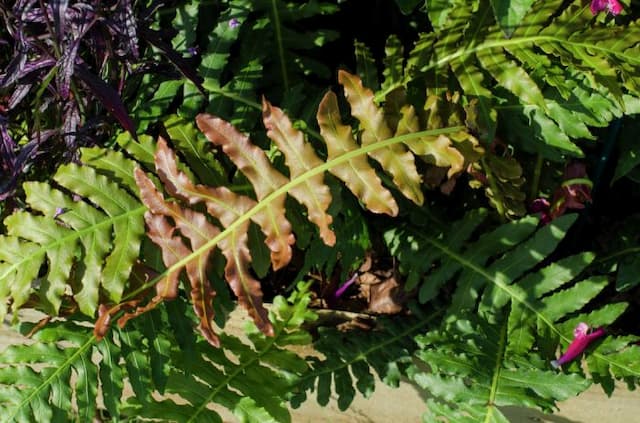
![Dwarf Brazilian tree fern [Eruption]](/_next/image?url=https%3A%2F%2Fplants-admin.emdemapps.com%2Fimages%2Fplants%2F%2Fimages%2F604b5592bbce2.png&w=640&q=75)
